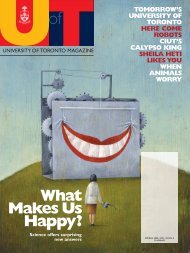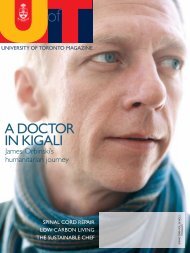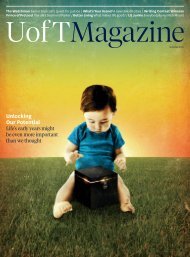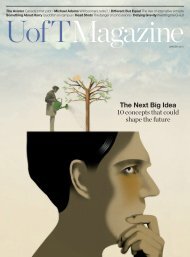8 MB - University of Toronto Magazine
8 MB - University of Toronto Magazine
8 MB - University of Toronto Magazine
- No tags were found...
Create successful ePaper yourself
Turn your PDF publications into a flip-book with our unique Google optimized e-Paper software.
Pr<strong>of</strong>essor Mohan Matthen is trying his best to answer this<br />
question. He is currently the principal investigator at the<br />
Network for Sensory Research, an international team <strong>of</strong> philosophers<br />
headquartered at U <strong>of</strong> T who believe it is high time<br />
we developed a new conceptual framework for the senses.<br />
It seems natural that philosophers should be leading this<br />
investigation; after all, it was Aristotle who originally conceived<br />
<strong>of</strong> the five-sense model to which we rigorously cling.<br />
And until the scientific method was developed in the 17 th<br />
century, investigation <strong>of</strong> the senses belonged to the philosophers<br />
alone. Today, they share the stage with neuroscientists,<br />
psychologists, medical doctors and biologists. And findings<br />
within these fields are reframing philosophical thinking in<br />
fascinating ways.<br />
Matthen himself came to philosophy via the sciences:<br />
his first degree was in physics, and he has also taught the<br />
philosophy <strong>of</strong> biology. His first exposure to the domain<br />
that would shape his life came when a teacher in his native<br />
India recommended that he read Appearance and Reality<br />
by the British metaphysician F.H. Bradley. On his chatty<br />
blog, Matthen jokes that the book (and his teacher) actually<br />
caused him “much misery”; nonetheless, it spurred him to<br />
study human perception.<br />
Other philosophers around the world have been probing<br />
the mystery <strong>of</strong> the senses for some time. Barry Smith,<br />
co-director <strong>of</strong> the <strong>University</strong> <strong>of</strong> London’s Centre for the Study<br />
<strong>of</strong> the Senses, is best known as a specialist in flavour and<br />
smell. Fiona Macpherson, who is the director <strong>of</strong> the <strong>University</strong><br />
<strong>of</strong> Glasgow’s Centre for the Study <strong>of</strong> Perceptual Experience,<br />
is an expert in the nature <strong>of</strong> visual experience, including optical<br />
illusions. Matthen has brought these researchers together<br />
– in person, when possible – with like-minded thinkers from<br />
Harvard, M.I.T. and elsewhere. “We want people to communicate,<br />
share each others’ work and get access to faculty<br />
members in other disciplines,” he says. “We’re particularly<br />
interested in multi-sensory integration and how the senses<br />
contribute to knowledge.”<br />
A key question the network wants to address is whether<br />
Aristotle’s model is still relevant. “The traditional five senses<br />
are external, but we’re also interested in the internal senses –<br />
those that have to do with a sense <strong>of</strong> what your own body<br />
is doing,” Matthen says. These include proprioception<br />
(knowing where your body is in space); nociception (the<br />
feeling <strong>of</strong> pain); and thermoception (temperature sense),<br />
among others.<br />
Matthen’s colleague Fiona Macpherson points out that<br />
animals have certain senses that we lack. “There are fish<br />
who are sensitive to electric fields. And there’s quite good<br />
evidence that some animals are sensitive to magnetic north,<br />
which we aren’t.” We humans might possess a vomeronasal<br />
organ – which animals famously use to sniff each others’<br />
pheromones – but the jury is still out on whether a human<br />
sense functions this way. So if we no longer have five senses,<br />
then how many do we have<br />
Like a practiced synesthete, I can see Matthen’s head shaking<br />
over the phone. “There’s not much point in counting<br />
them,” he says. “What we’re more interested in is how they<br />
come together.” Barry Smith expands on this. “You could<br />
have more than one sense <strong>of</strong> smell, because you’ve got the<br />
smelling from the outside in when you take a breath. But<br />
you’re also smelling aromas that enter the sinus cavity from<br />
inside the mouth.”<br />
An explanation: when I attend one <strong>of</strong> Smith’s talks, he <strong>of</strong>fers<br />
everyone in attendance a jelly bean, and tells us to hold our<br />
nose while chewing. My jelly bean is coconut-flavoured; with<br />
my nose held, I can only perceive that it’s “sweet” (in that<br />
respect, no different in any way from raspberry or chocolate).<br />
The coconut flavour only becomes apparent when I unplug<br />
my nose. Smith’s point is clear: what we call “flavour” is a<br />
blend <strong>of</strong> tongue-taste and smell. “None <strong>of</strong> the parts operate<br />
separately anyway,” he says. “So how can we think <strong>of</strong> them<br />
as parts”<br />
None <strong>of</strong> the parts operate separately. It’s an idea that<br />
completely upends what we all learned as schoolchildren:<br />
there are five individuated senses, some more cherished than<br />
others. And yet we know from experience how integrated<br />
they all must be. When we have a cold, for example, taste and<br />
smell are equally diminished. And instinctively, we know<br />
that beautifully presented food somehow tastes better.<br />
Sensory fusion is also illustrated by the McGurk effect,<br />
where you watch a mouth forming the sound “ga” while the<br />
sound “ba” is being played. What you will then hear is wrong:<br />
it’s the sound “da,” the midpoint between the two. (There are<br />
several video demonstrations <strong>of</strong> this effect on YouTube.)<br />
“So the question is, do we partly hear with our eyes” asks<br />
Smith. “And the thought seems to be, yes. You’re fusing hearing<br />
and vision to make some new product. The way we’re<br />
talking about hearing and vision no longer depends on input<br />
from just one sense, and as a result we’ve had to tear up our<br />
old ideas.”<br />
And yet, it’s not as if Aristotle was completely wrong: there<br />
are dividing lines, but where are they On a sunny day in May,<br />
Matthen gathers members <strong>of</strong> the network at a wine-tasting in<br />
the Niagara region <strong>of</strong> Ontario. Smith is, among other things,<br />
an oenophile – wine-tasting being a discipline that naturally<br />
combines all the senses at once. “Smell this!” he demands,<br />
pr<strong>of</strong>fering a glass <strong>of</strong> Riesling. “It has notes <strong>of</strong> diesel and lime.”<br />
This doesn’t sound inviting, and Smith is right: what I inhale<br />
seems nothing less than mildly citric gasoline.<br />
But tasting is a different matter altogether. On drinking the<br />
wine, I perceive it as sweet and floral, its flavour only a distant<br />
cousin to its scent. Smith says this disconnection is common<br />
in the flavour business. He points out the example <strong>of</strong> Époisses<br />
cheese, which tastes delightful but smells like a “teenager’s<br />
training shoe.” It’s clear that there are separate perceptual<br />
systems operating here. But the war may not be between<br />
smell and taste – instead, it could be one <strong>of</strong> my smell-senses<br />
rejecting the information from another.<br />
28 WWW.MAGAZINE.UTORONTO.CA
















